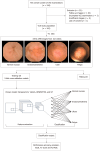Classification of pediatric video capsule endoscopy images for small bowel abnormalities using deep learning models
- PMID: 40538507
- PMCID: PMC12175855
- DOI: 10.3748/wjg.v31.i21.107601
Classification of pediatric video capsule endoscopy images for small bowel abnormalities using deep learning models
Abstract
Background: Video capsule endoscopy (VCE) is a noninvasive technique used to examine small bowel abnormalities in both adults and children. However, manual review of VCE images is time-consuming and labor-intensive, making it crucial to develop deep learning methods to assist in image analysis.
Aim: To employ deep learning models for the automatic classification of small bowel lesions using pediatric VCE images.
Methods: We retrospectively analyzed VCE images from 162 pediatric patients who underwent VCE between January 2021 and December 2023 at the Children's Hospital of Nanjing Medical University. A total of 2298 high-resolution images were extracted, including normal mucosa and lesions (erosions/erythema, ulcers, and polyps). The images were split into training and test datasets in a 4:1 ratio. Four deep learning models: DenseNet121, Visual geometry group-16, ResNet50, and vision transformer were trained using 5-fold cross-validation, with hyperparameters adjusted for optimal classification performance. The models were evaluated based on accuracy, precision, recall, F1-score, and area under the receiver operating curve (AU-ROC). Lesion visualization was performed using gradient-weighted class activation mapping.
Results: Abdominal pain was the most common indication for VCE, accounting for 62% of cases, followed by diarrhea, vomiting, and gastrointestinal bleeding. Abnormal lesions were detected in 93 children, with 38 diagnosed with inflammatory bowel disease. Among the deep learning models, DenseNet121 and ResNet50 demonstrated excellent classification performance, achieving accuracies of 90.6% [95% confidence interval (CI): 89.2-92.0] and 90.5% (95%CI: 89.9-91.2), respectively. The AU-ROC values for these models were 93.7% (95%CI: 92.9-94.5) for DenseNet121 and 93.4% (95%CI: 93.1-93.8) for ResNet50.
Conclusion: Our deep learning-based diagnostic tool developed in this study effectively classified lesions in pediatric VCE images, contributing to more accurate diagnoses and increased diagnostic efficiency.
Keywords: Children; Convolutional neural network; Deep learning; Erosion; Polyp; Ulcer; Video capsule endoscopy; Vision transformer.
©The Author(s) 2025. Published by Baishideng Publishing Group Inc. All rights reserved.
Conflict of interest statement
Conflict-of-interest statement: The authors declare that they have no conflict of interest.
Figures


Similar articles
-
Retention associated with video capsule endoscopy: systematic review and meta-analysis.Gastrointest Endosc. 2017 Jun;85(6):1157-1168.e2. doi: 10.1016/j.gie.2016.12.024. Epub 2017 Jan 6. Gastrointest Endosc. 2017. PMID: 28069475
-
A deep learning approach to direct immunofluorescence pattern recognition in autoimmune bullous diseases.Br J Dermatol. 2024 Jul 16;191(2):261-266. doi: 10.1093/bjd/ljae142. Br J Dermatol. 2024. PMID: 38581445
-
Deep learning-based localization and lesion detection in capsule endoscopy for patients with suspected small-bowel bleeding.World J Gastroenterol. 2025 Jul 21;31(27):106819. doi: 10.3748/wjg.v31.i27.106819. World J Gastroenterol. 2025. PMID: 40741104 Free PMC article.
-
Diagnostic yield of video capsule endoscopy vs simple balloon enteroscopy in small intestinal disorders: A systematic review.World J Gastrointest Endosc. 2025 Jul 16;17(7):108264. doi: 10.4253/wjge.v17.i7.108264. World J Gastrointest Endosc. 2025. PMID: 40677578 Free PMC article.
-
Diagnostic Yield of Video Capsule Endoscopy (VCE) in Celiac Disease (CD): A Systematic Review and Meta-analysis.J Clin Gastroenterol. 2025 Aug 1;59(7):598-606. doi: 10.1097/MCG.0000000000002204. J Clin Gastroenterol. 2025. PMID: 40434820
References
-
- Iddan G, Meron G, Glukhovsky A, Swain P. Wireless capsule endoscopy. Nature. 2000;405:417. - PubMed
-
- Thomson M, Fritscher-Ravens A, Mylonaki M, Swain P, Eltumi M, Heuschkel R, Murch S, McAlindon M, Furman M. Wireless capsule endoscopy in children: a study to assess diagnostic yield in small bowel disease in paediatric patients. J Pediatr Gastroenterol Nutr. 2007;44:192–197. - PubMed
-
- Cohen SA, Ephrath H, Lewis JD, Klevens A, Bergwerk A, Liu S, Patel D, Reed-Knight B, Stallworth A, Wakhisi T, Gold BD. Pediatric capsule endoscopy: review of the small bowel and patency capsules. J Pediatr Gastroenterol Nutr. 2012;54:409–413. - PubMed
-
- Friedlander JA, Liu QY, Sahn B, Kooros K, Walsh CM, Kramer RE, Lightdale JR, Khlevner J, McOmber M, Kurowski J, Giefer MJ, Pall H, Troendle DM, Utterson EC, Brill H, Zacur GM, Lirio RA, Lerner DG, Reynolds C, Gibbons TE, Wilsey M, Liacouras CA, Fishman DS Endoscopy Committee. NASPGHAN Capsule Endoscopy Clinical Report. J Pediatr Gastroenterol Nutr. 2017;64:485–494. - PubMed
-
- Jensen MK, Tipnis NA, Bajorunaite R, Sheth MK, Sato TT, Noel RJ. Capsule endoscopy performed across the pediatric age range: indications, incomplete studies, and utility in management of inflammatory bowel disease. Gastrointest Endosc. 2010;72:95–102. - PubMed
MeSH terms
LinkOut - more resources
Full Text Sources

